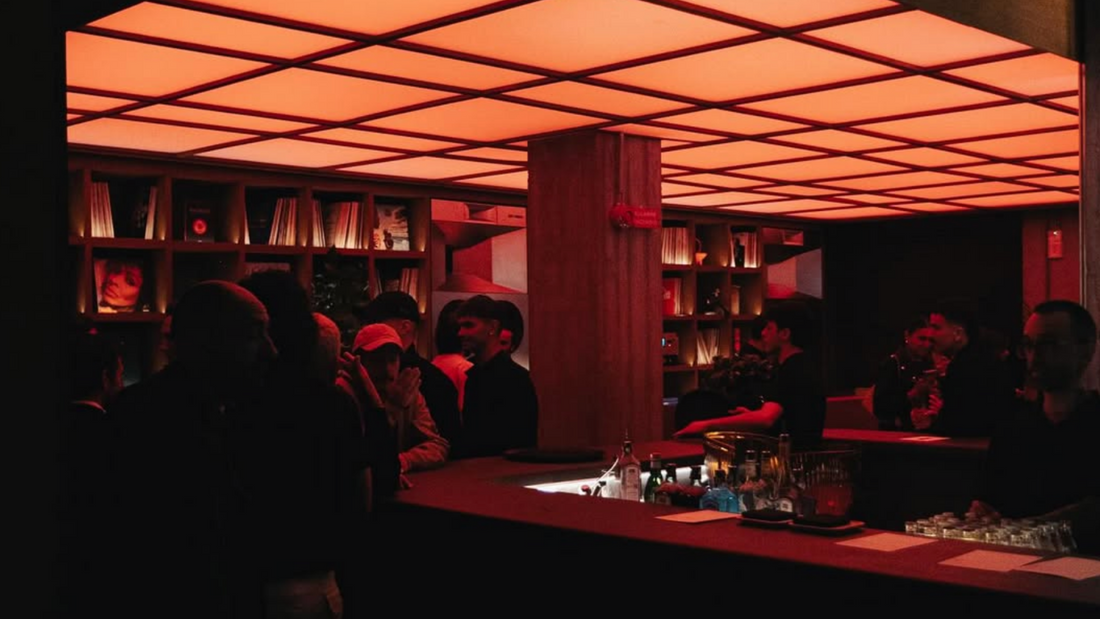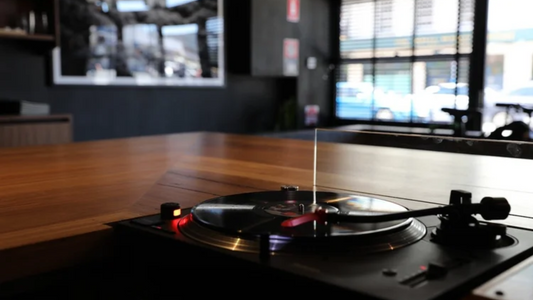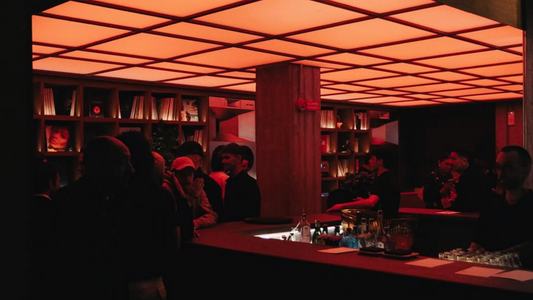
Amber Frequencies in Isola: An Evening at MOGO
By Rafi Mercer
New Listing
MOGO is one of Isola, Milan’s most considered listening bars — explore more in our Italy Music Venues guide.
Venue Name: MOGO
Address: Via Bernina 1C, Milano 20158, Italy
Website: MOGO
Instagram: @mogo.hifi
The first time you step into MOGO, the streets of Isola fall away in an instant, like fading static cut by the drop of a stylus. Milan’s bustle recedes as you cross the threshold, replaced by something more deliberate: a room tuned to listening, designed to slow time and sharpen attention. What looks from outside like a quiet warehouse conversion reveals itself within as a sanctuary of light, texture, and sound.
The interior is composed with care. Giorgia Longoni Studio has shaped the space as a hybrid between a restaurant and a listening chamber, every surface weighted with intention. The palette is a dialogue of opposites—industrial concrete softened by velvet banquettes, steel lines offset by woven tapestries from Andrea Marco Corvino that dance with surreal folklore. Even before the music starts, the space whispers of reverence. Light pools in amber tones across the bar, shifting gradually through the evening until the room itself seems to inhale and exhale with the rhythm of the night.
At its heart, the circular bar is both stage and anchor. Around it, the room orbits: conversation low, glasses catching the glow, vinyl ready to spin. Behind it rises the DJ booth, sculpted like a shrine. Within are housed the H.A.N.D. Hi-Fi speakers—rich, hand-crafted instruments—paired with a custom installation by Berlin’s Sound Metaphors. This is no off-the-shelf system. It is tuned like a grand piano, calibrated to draw out warmth and clarity in equal measure. Each note feels like a tangible shape, gliding through the air with geometry you can almost trace in your hands.
The sound does not press against you; it enfolds you. Bass settles in the floor, steady and tactile. Cymbals lift into the upper air with crystalline ease. Voices inhabit the midrange like presences in the room. It is the kind of fidelity that does not flaunt its power but convinces through restraint—allowing silence its place, letting dynamics breathe. In MOGO, you realise quickly: this is not music as wallpaper, but as architecture.
Programming here reflects that philosophy. Partners like Polifonic and Burro Studio curate a spectrum that stretches from Japanese ambient to Italian jazz, from deep-cut soul to electronic textures. Nights unfold as narratives, not playlists—each record a sentence in a larger story. On some evenings, a DJ eases into extended ambient passages that seem to suspend the room in mid-air. On others, a slow-burning disco groove unfurls, heads nodding in unison. It is never obvious, never background; it always asks for your ear.
The kitchen under Yoji Tokuyoshi amplifies this ethos. Sharing plates arrive with a sense of balance and surprise: asparagus lifted with tofu and sesame, chicken thigh lacquered in teriyaki, anchovy laid with wasabi on soft shokupan focaccia. These are compositions in miniature—Japanese sensibility refracted through Milanese expression. Each dish feels like a counterpoint to the sound, another layer in the mix.
Drinks carry the same intent. The Tokyo Dub blends sake, tequila, yuzu and mint into a composition as refreshing as it is dissonant. Dark Funk, a heady mix of rum, ginger, licorice and chinotto, lands with a syncopated kick. Even the Martini Black Saffron feels tuned to the city’s baroque silhouette, cardamom echoing the gold of the Duomo. Cocktails here are not garnish; they are another voice in the ensemble.
What binds it all together is consistency. MOGO does not treat listening as a trend or a gimmick. Week after week, the system is maintained, the programming considered, the service aligned with the ethos. From a hushed weekday lunch to a crowded Friday night session, the level never falters. It is a bar that earns trust, because its devotion to listening never wavers.
The physical geometry of the room aids that mission. Narrow at the entrance, it expands into a wider chamber where sound disperses evenly. Ceilings rise just enough to allow resonance without echo. Materials absorb and reflect in balance. You can converse at your table, but you always know where the centre lies—the invisible circle around the speakers, where the listening is most acute. Step into that zone, and the music claims you whole.
MOGO belongs to a wider lineage—the kissaten of Tokyo, the speakeasy listening rooms of New York, the precision-tuned bars of London. Yet it speaks with a Milanese accent. The design is Italian in its fluency, the hospitality rooted in the city’s culture of craft, the curation international but refracted through local sensibility. It is not imitation but interpretation, a translation of a global listening culture into the language of Milan.
On certain nights, as the final record side spins into silence, there is a collective pause—an inhalation that no one wants to break. In that pause, you understand what MOGO has built: a room where listening itself is the luxury, where sound is not consumed but shared. Walking back into Isola, with its tramlines humming and its apartments leaning into the night, you carry that silence with you. It feels weightier than the noise it replaces, like a memory you can still hear.
Rafi Mercer writes about the spaces where music matters. For more stories from Tracks & Tales, subscribe, or click here to read more.






